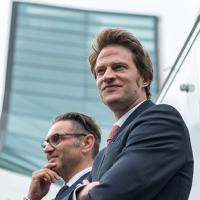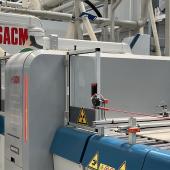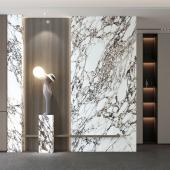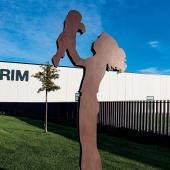Durst opens its futuristic new headquarters

On 5 April, Durst opened its new headquarters in Brixen, northern Italy, a futuristic building that represents the group’s process of evolution.
Durst, a global leader in the production of inkjet printing systems for industrial applications, recently opened its new headquarters in a futuristic building set amongst the mountains of Brixen in South Tyrol. The building’s iconic design consists of a flat, floating wing structure with a 35-metre six-storey concrete tower and a metal powder-coated façade, where 850 multicoloured LED-illuminated windows are arranged in a pixel-like fashion reminiscent of the world of photography and digital printing,
This highly futuristic building took almost two years to complete and was finally opened on 5 April. It was designed by architects Patrik Pedò and Juri Pobitzer from the Bolzano-based practice Monovolume, who integrated the new wing with the existing headquarters and production facility while at the same time creating a powerful connection between past and future. The iconic design for a company building with a tower was first presented more than 50 years ago by architect Othmar Barth, creator of the first Durst facility, although it remained unbuilt.
Past and future were also the key themes of the inauguration ceremony for the new headquarters, an event that was attended by more than 1,000 guests including customers, employees, business partners and representatives of local authorities. They were welcomed by CEO and Co-Owner Christoph Gamper together with Harald and Christof Oberrauch, representatives of the family that has owned Durst for three generations.
“This is a very proud day in the long history of Durst,” Christoph Gamper told guests in his welcoming remarks. “We do not fear the future. We are here to shape the future. We have the best employees, the best customers and the best technology. Driven by the mantra of innovation, we offer complete solutions from pixel to output, without forgetting that the aim is to focus not just on machines but also on the people behind them.”
The new building itself, which occupies 5,700 square metres of a total 28,000 sq.m site, reflects Durst’s strong focus on the well-being of its employees. The building hosts executive, commercial and technical offices combining comfort and hi-tech features. A large window looks out onto a 2,800 sq.m raised garden for use by employees and customers; there are various well-equipped relaxation areas, including a large cafeteria at the entrance, as well as spaces for a professional baby-sitting service.
This visually-striking building also features a modern conference hall and the prestigious Customer Experience Center. In this enormous showroom, customers from all over the world can try out the entire range of Durst solutions, high-performance digital printing systems for sectors spanning visual communication, ceramics, packaging and textiles.
The new headquarters reflects the Group’s long-term strategies. “Over the next few decades, we will see Durst evolve from a specialist in digital inkjet printing to a supplier of complete solutions such as image and data acquisition, printing and surface decoration, including the development of proprietary workflow software, ink development and constant implementation of pre- and after-sales services,” explained Gamper.
This transition has been led by Gamper himself, who has introduced a new management structure and a new business philosophy based on a passion for technologies and markets, active collaboration and participation aimed at shaping the future through the driver of innovation. “It is not a question of appearance but of essence”, he concluded. “With this building we wanted to create a protected space for innovation, bringing together very special people who have devoted themselves to creating something new and who are always ready to ask the next question.”
With its more than 80-year history closely associated with the Oberrauch family, Durst employs more than 700 people (including 280 at the headquarters in Brixen) and has 20 subsidiaries worldwide and 295 patents. Harald Oberrauch recently took over the reins of the company from his father Christof.
Did you find this article useful?
Join the CWW community to receive the most important news from the global ceramic industry every two weeks





















